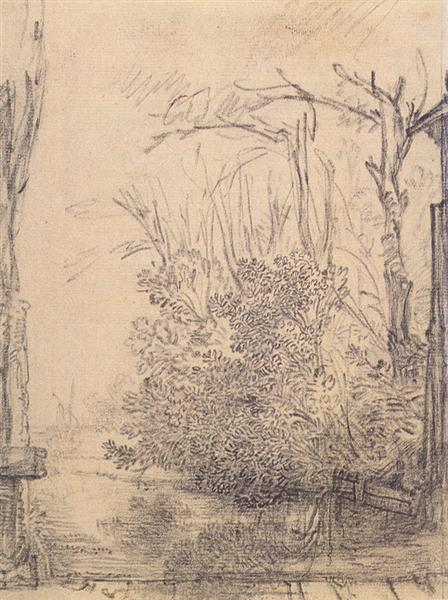Beskrivning
Rembrandt's painting "Hanging Bushes in a Ditch", dated around 1640, is part of the rich legacy of the Dutch master, who is known for his astonishing handling of light and shadow, as well as his extraordinary ability to evoke emotions through landscape. In this work, Rembrandt presents us with a natural environment that, on the surface, may seem simple or even trivial. However, this thematic choice reflects a profound mastery in capturing the ethereal essence and the passage of time in nature.
The composition of the work is characterised by a deliberate use of tilt and visual tension. A dense bush in the foreground of the work stands out with its lushness, while the ditch provides an opening that directs the viewer’s gaze towards a brighter background. This contrast between the darkness of the foreground and the lightness of the background not only frames the work in a dynamic way, but also represents a duality of the known and the unknown, the hidden and the visible. The texture of the bushes is particularly notable; Rembrandt uses different brushstroke techniques that bring a sense of three-dimensionality and realism. The colours focus on an earthy palette that conveys a sense of authenticity in the depiction of the natural environment. The combination of muted greens, browns and ochres reinforces the organicity of the landscape, enhancing the viewer’s connection with nature.
Rembrandt was a master of chiaroscuro, a technique that plays a fundamental role in this work. The light that filters through the leaves and reflects on the ditch creates an almost magical effect, illuminating these details of nature with an evocative clarity that highlights their beauty and fragility. However, Rembrandt's handling of light is subtle; he avoids excessive contrast that could be dramatic. Instead, he opts for a luminosity that suggests a serene contemplation, a moment suspended in time where nature and the viewer meet in a silent dialogue.
It is interesting to note that in this work there are no human figures to distract the viewer's attention. The absence of characters highlights the introspection of the landscape and its importance as a subject in itself. This aesthetic choice can lead the viewer to a meditation on the relationship between man and nature, a recurring theme in 17th century landscapes, especially in Dutch art. Through this work, Rembrandt invites us to reflect on the spaces we inhabit, the beauty that we often overlook in our daily lives.
“Hanging Bushes in a Ditch” is ultimately a testament to Rembrandt’s ability to transform the ordinary into the extraordinary. Despite the apparent simplicity of its composition, every detail is imbued with his distinct artistic vision. This work resembles other works of the period in its exploration of nature, but is distinguished by Rembrandt’s impeccable focus on the nuances of light and color, suggesting that the landscape, despite its stillness, is full of life and movement. In an era where landscape as an artistic subjectivity was on the rise, Rembrandt, true to his personal style, managed to capture and transform these fleeting moments into lasting reflections on life, time, and the human experience.
KUADROS ©, a famous painting on your wall.
Hand-made oil painting reproductions, with the quality of professional artists and the distinctive seal of KUADROS ©.
Painting reproduction service with satisfaction guarantee. If you are not completely satisfied with the replica of your painting, we will refund 100% of your money.

